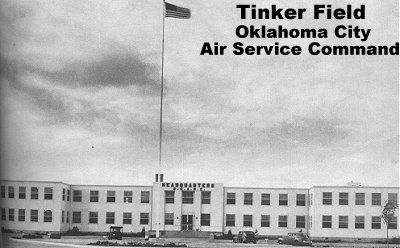Tinker Air Force Base

 OKGenWeb
Project
OKGenWeb
Project

| This material is donated by people who want to communicate with and help others. Every effort is made to give credit and protect all copyrights. Presentation here does not extend any permissions to the public. This material can not be included in any compilation, publication, collection, or other reproduction for profit without permission. |
History Of Oklahoma City Air Service Command
Tinker Air Force Base

The first official announcement the the Air Forces would build a depot at
Oklahoma City came on April 8, 1941, and the first contract for construction
came on July 25. Workmen moved into the area within a few days. One hundred
and twenty days was called for on the production plans, but expansion of
the plans, plus adverse weather conditions, contrived to make the construction
period take a year. Despite these obstacles....and the knee-deep red
mud...construction on the permanent depot buildings was 75 per cent complete
on July 1, 1942...slightly ahead of schedule. Official activation of the
depot was on March 1, 1942.
The first contingent of troops for the depot arrived on April 1 and were
quartered in a temporary Tent City, southwest of the city. Tent City was
begun March 15 and was completed late in April. It accommodated over 1,000
men in 190 tents.
The cadre for the first air depot group to go into training at Oklahoma City
arrived April 18, from Duncan Field, Texas, under the command of Captain
Sylvester F. MORRISON. The first commanding officer of the base was Colonel
William TURNBULL.
The $35,000,000 project today covers 2,400 acres.
Although its growth has been phenomenal, OCASC is no temporary project. Though
it may shrink somewhat from its present peak there is every indication that
it will serve our good sized Air Force for many years to come. Tinker Field,
with its many paved runways and a swiftly growing air freight terminal, can
serve the cargo ships of peace as well as those carrying war freight. Its
16-acre repair building is a substantial, steel-and-concrete structure, as
are its hangars. Its supply buildings have been built to last. Its civilian
personnel are mostly men and women from the surrounding neighborhoods. They
are men and women who consider themselves as part of the community, who consider
their Civil Service jobs as more than temporary avocations. OCASC is playing
a vital role in winning the war; as a permanent service organization it should
do much in keeping the peace.